Nestle: Multinational Companies' Recruitment, Selection, and Training
VerifiedAdded on 2021/02/19
|23
|4985
|21
Report
AI Summary
This report examines how multinational companies, specifically using Nestle as a case study, improve their recruitment, selection, and training processes to meet international requirements. The report begins with an introduction outlining the importance of adapting HR practices for global operations. Task 1 defines the project's aims, objectives, and research questions, followed by a project management plan covering costs, scope, time, quality, communication, and risks. A work breakdown structure (WBS) and Gantt chart are also included. Task 2 details the research methodologies employed, including primary and secondary research, qualitative and quantitative approaches, and sampling techniques, with an example questionnaire. Task 3 presents data analysis and interpretation, followed by recommendations for improvement, and a reflection on the research process. The report concludes by summarizing the key findings and providing references and appendices, including a logbook and performance review.
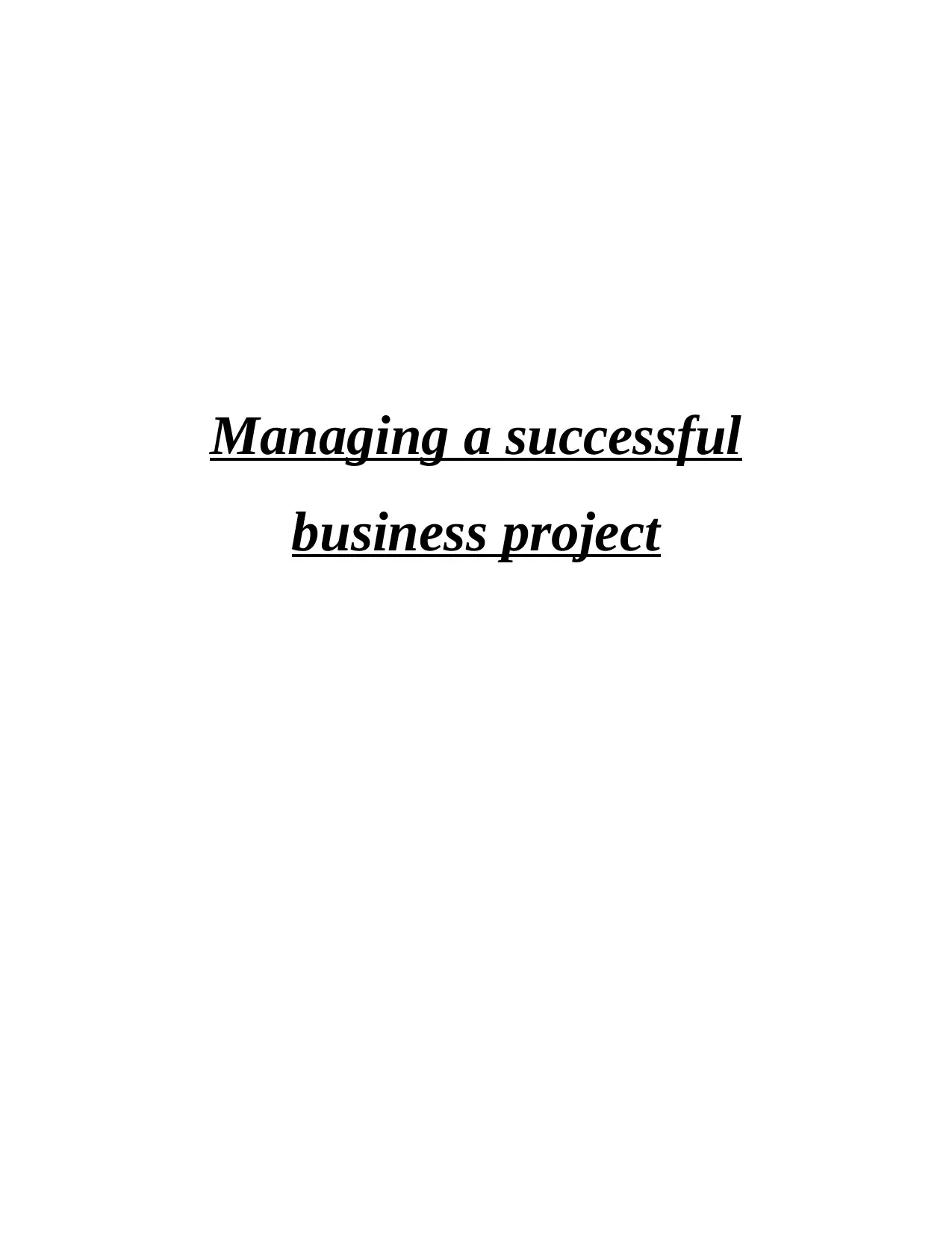
Managing a successful
business project
business project
Paraphrase This Document
Need a fresh take? Get an instant paraphrase of this document with our AI Paraphraser
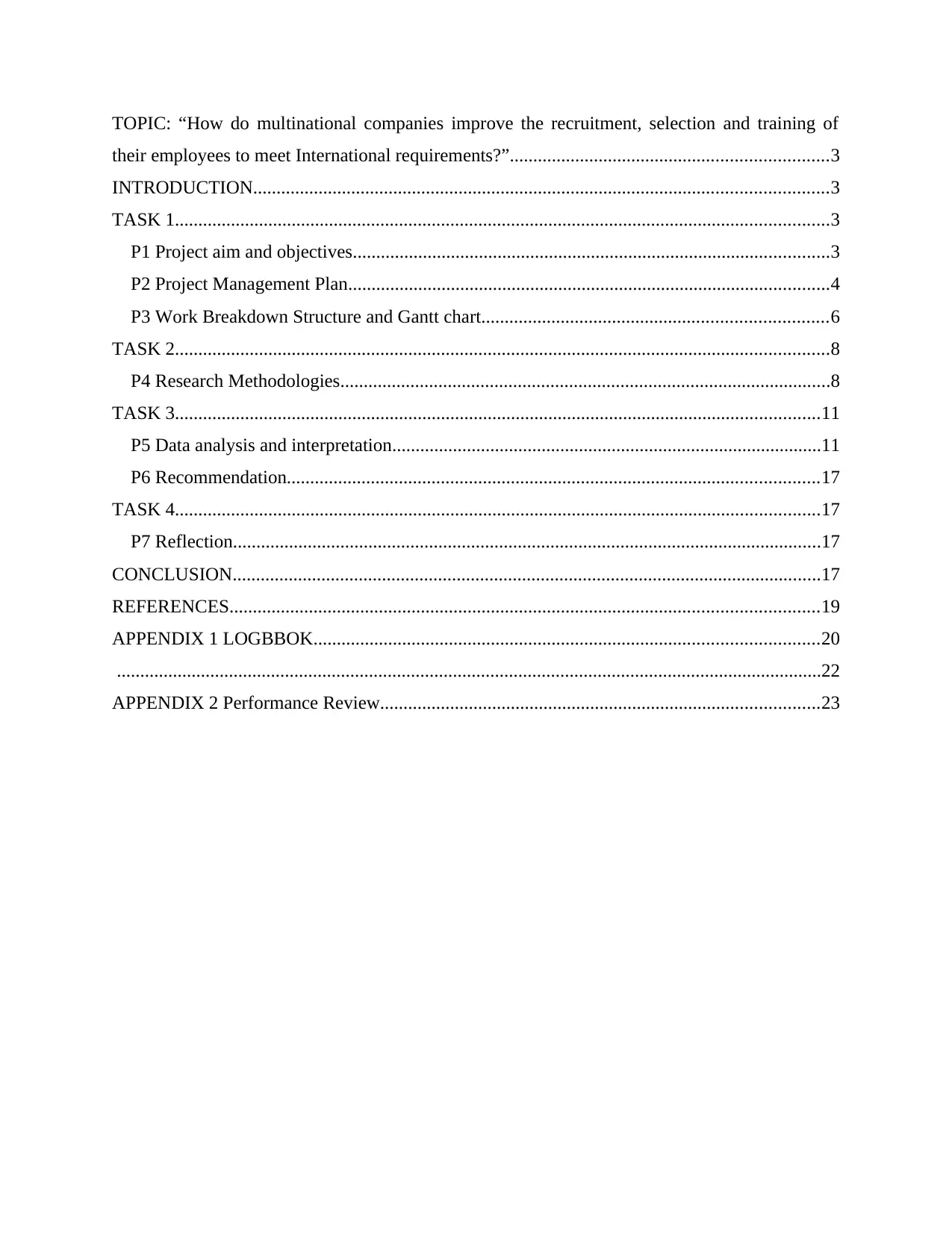
TOPIC: “How do multinational companies improve the recruitment, selection and training of
their employees to meet International requirements?”....................................................................3
INTRODUCTION...........................................................................................................................3
TASK 1............................................................................................................................................3
P1 Project aim and objectives......................................................................................................3
P2 Project Management Plan.......................................................................................................4
P3 Work Breakdown Structure and Gantt chart..........................................................................6
TASK 2............................................................................................................................................8
P4 Research Methodologies.........................................................................................................8
TASK 3..........................................................................................................................................11
P5 Data analysis and interpretation............................................................................................11
P6 Recommendation..................................................................................................................17
TASK 4..........................................................................................................................................17
P7 Reflection..............................................................................................................................17
CONCLUSION..............................................................................................................................17
REFERENCES..............................................................................................................................19
APPENDIX 1 LOGBBOK............................................................................................................20
.......................................................................................................................................................22
APPENDIX 2 Performance Review..............................................................................................23
their employees to meet International requirements?”....................................................................3
INTRODUCTION...........................................................................................................................3
TASK 1............................................................................................................................................3
P1 Project aim and objectives......................................................................................................3
P2 Project Management Plan.......................................................................................................4
P3 Work Breakdown Structure and Gantt chart..........................................................................6
TASK 2............................................................................................................................................8
P4 Research Methodologies.........................................................................................................8
TASK 3..........................................................................................................................................11
P5 Data analysis and interpretation............................................................................................11
P6 Recommendation..................................................................................................................17
TASK 4..........................................................................................................................................17
P7 Reflection..............................................................................................................................17
CONCLUSION..............................................................................................................................17
REFERENCES..............................................................................................................................19
APPENDIX 1 LOGBBOK............................................................................................................20
.......................................................................................................................................................22
APPENDIX 2 Performance Review..............................................................................................23
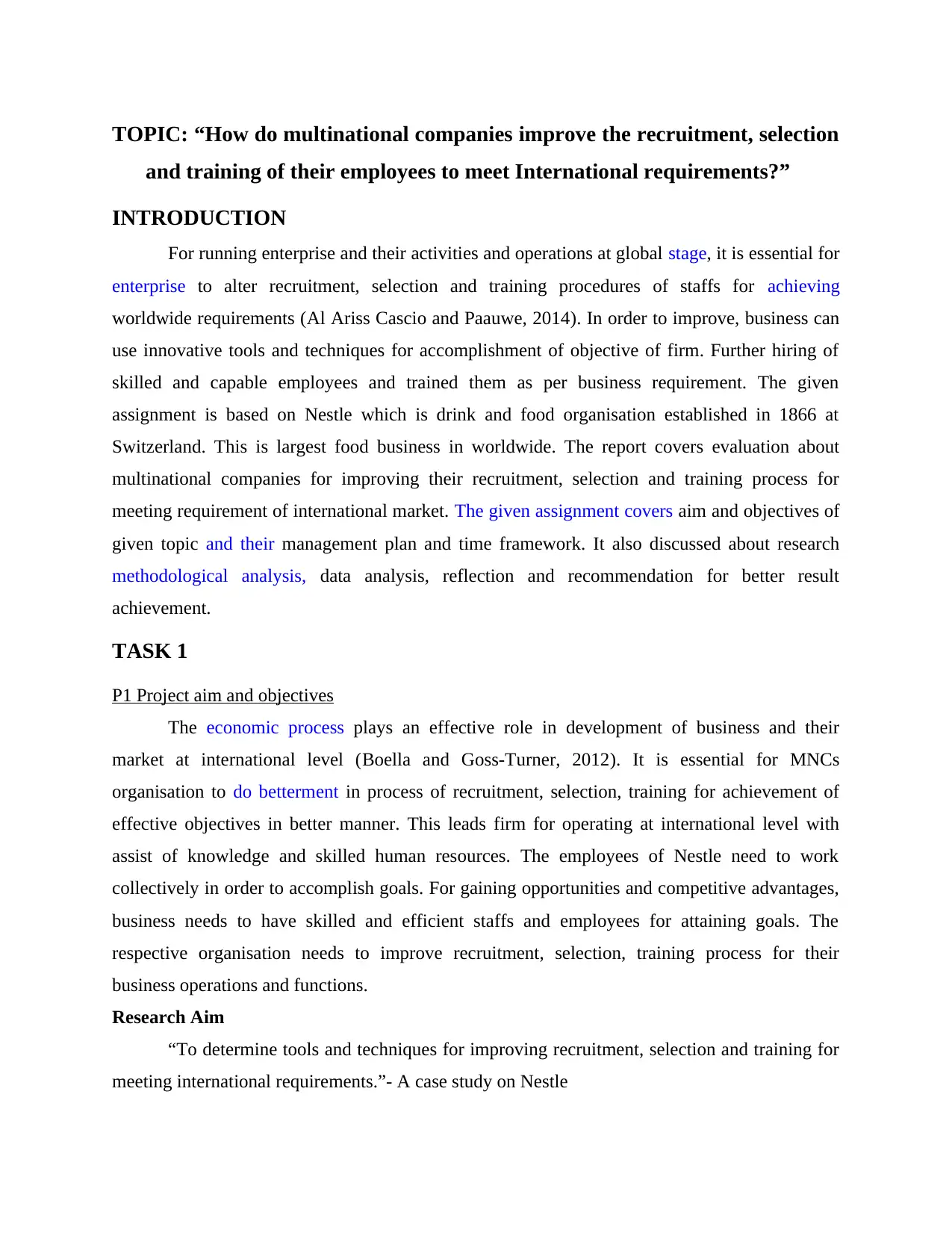
TOPIC: “How do multinational companies improve the recruitment, selection
and training of their employees to meet International requirements?”
INTRODUCTION
For running enterprise and their activities and operations at global stage, it is essential for
enterprise to alter recruitment, selection and training procedures of staffs for achieving
worldwide requirements (Al Ariss Cascio and Paauwe, 2014). In order to improve, business can
use innovative tools and techniques for accomplishment of objective of firm. Further hiring of
skilled and capable employees and trained them as per business requirement. The given
assignment is based on Nestle which is drink and food organisation established in 1866 at
Switzerland. This is largest food business in worldwide. The report covers evaluation about
multinational companies for improving their recruitment, selection and training process for
meeting requirement of international market. The given assignment covers aim and objectives of
given topic and their management plan and time framework. It also discussed about research
methodological analysis, data analysis, reflection and recommendation for better result
achievement.
TASK 1
P1 Project aim and objectives
The economic process plays an effective role in development of business and their
market at international level (Boella and Goss-Turner, 2012). It is essential for MNCs
organisation to do betterment in process of recruitment, selection, training for achievement of
effective objectives in better manner. This leads firm for operating at international level with
assist of knowledge and skilled human resources. The employees of Nestle need to work
collectively in order to accomplish goals. For gaining opportunities and competitive advantages,
business needs to have skilled and efficient staffs and employees for attaining goals. The
respective organisation needs to improve recruitment, selection, training process for their
business operations and functions.
Research Aim
“To determine tools and techniques for improving recruitment, selection and training for
meeting international requirements.”- A case study on Nestle
and training of their employees to meet International requirements?”
INTRODUCTION
For running enterprise and their activities and operations at global stage, it is essential for
enterprise to alter recruitment, selection and training procedures of staffs for achieving
worldwide requirements (Al Ariss Cascio and Paauwe, 2014). In order to improve, business can
use innovative tools and techniques for accomplishment of objective of firm. Further hiring of
skilled and capable employees and trained them as per business requirement. The given
assignment is based on Nestle which is drink and food organisation established in 1866 at
Switzerland. This is largest food business in worldwide. The report covers evaluation about
multinational companies for improving their recruitment, selection and training process for
meeting requirement of international market. The given assignment covers aim and objectives of
given topic and their management plan and time framework. It also discussed about research
methodological analysis, data analysis, reflection and recommendation for better result
achievement.
TASK 1
P1 Project aim and objectives
The economic process plays an effective role in development of business and their
market at international level (Boella and Goss-Turner, 2012). It is essential for MNCs
organisation to do betterment in process of recruitment, selection, training for achievement of
effective objectives in better manner. This leads firm for operating at international level with
assist of knowledge and skilled human resources. The employees of Nestle need to work
collectively in order to accomplish goals. For gaining opportunities and competitive advantages,
business needs to have skilled and efficient staffs and employees for attaining goals. The
respective organisation needs to improve recruitment, selection, training process for their
business operations and functions.
Research Aim
“To determine tools and techniques for improving recruitment, selection and training for
meeting international requirements.”- A case study on Nestle
⊘ This is a preview!⊘
Do you want full access?
Subscribe today to unlock all pages.

Trusted by 1+ million students worldwide
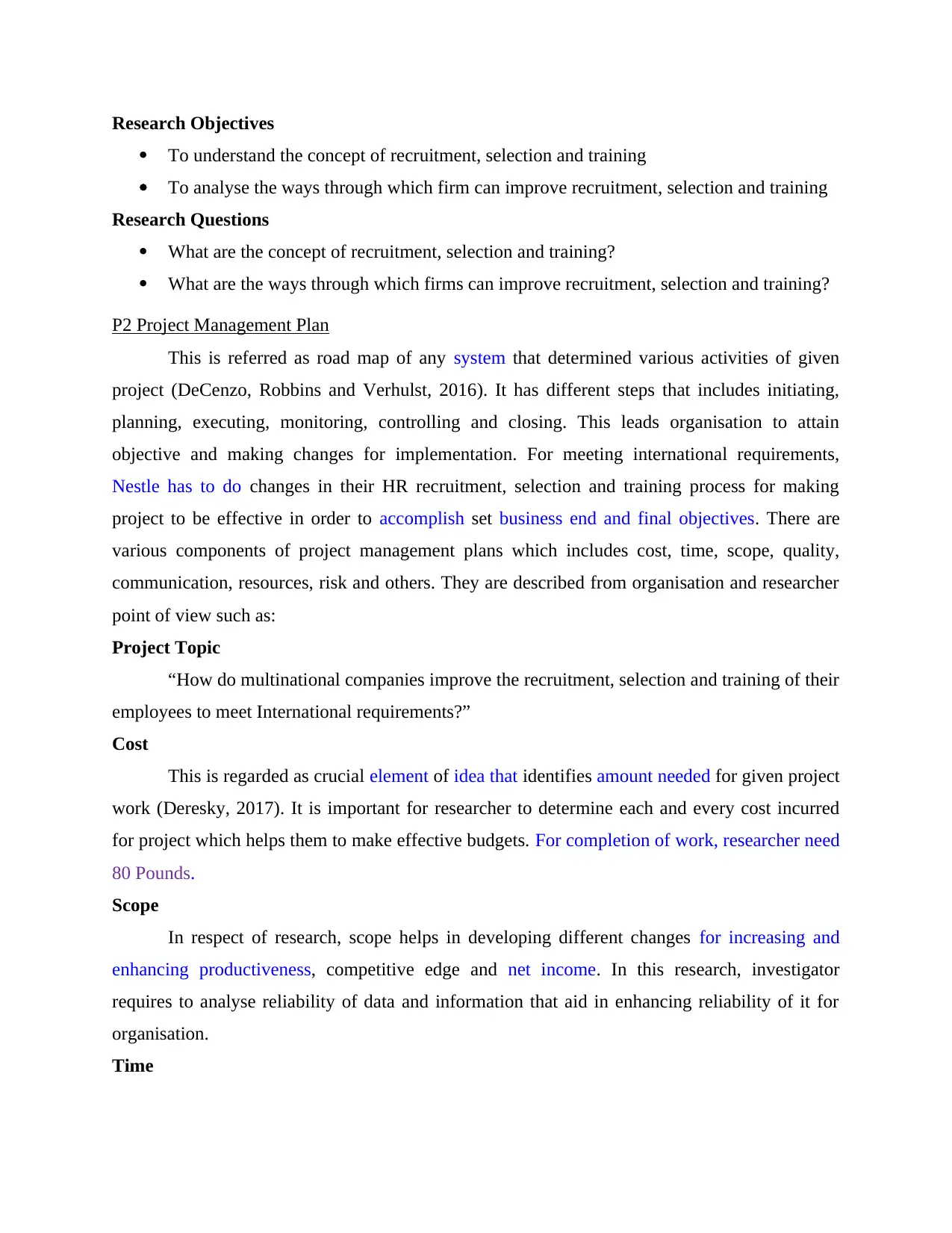
Research Objectives
To understand the concept of recruitment, selection and training
To analyse the ways through which firm can improve recruitment, selection and training
Research Questions
What are the concept of recruitment, selection and training?
What are the ways through which firms can improve recruitment, selection and training?
P2 Project Management Plan
This is referred as road map of any system that determined various activities of given
project (DeCenzo, Robbins and Verhulst, 2016). It has different steps that includes initiating,
planning, executing, monitoring, controlling and closing. This leads organisation to attain
objective and making changes for implementation. For meeting international requirements,
Nestle has to do changes in their HR recruitment, selection and training process for making
project to be effective in order to accomplish set business end and final objectives. There are
various components of project management plans which includes cost, time, scope, quality,
communication, resources, risk and others. They are described from organisation and researcher
point of view such as:
Project Topic
“How do multinational companies improve the recruitment, selection and training of their
employees to meet International requirements?”
Cost
This is regarded as crucial element of idea that identifies amount needed for given project
work (Deresky, 2017). It is important for researcher to determine each and every cost incurred
for project which helps them to make effective budgets. For completion of work, researcher need
80 Pounds.
Scope
In respect of research, scope helps in developing different changes for increasing and
enhancing productiveness, competitive edge and net income. In this research, investigator
requires to analyse reliability of data and information that aid in enhancing reliability of it for
organisation.
Time
To understand the concept of recruitment, selection and training
To analyse the ways through which firm can improve recruitment, selection and training
Research Questions
What are the concept of recruitment, selection and training?
What are the ways through which firms can improve recruitment, selection and training?
P2 Project Management Plan
This is referred as road map of any system that determined various activities of given
project (DeCenzo, Robbins and Verhulst, 2016). It has different steps that includes initiating,
planning, executing, monitoring, controlling and closing. This leads organisation to attain
objective and making changes for implementation. For meeting international requirements,
Nestle has to do changes in their HR recruitment, selection and training process for making
project to be effective in order to accomplish set business end and final objectives. There are
various components of project management plans which includes cost, time, scope, quality,
communication, resources, risk and others. They are described from organisation and researcher
point of view such as:
Project Topic
“How do multinational companies improve the recruitment, selection and training of their
employees to meet International requirements?”
Cost
This is regarded as crucial element of idea that identifies amount needed for given project
work (Deresky, 2017). It is important for researcher to determine each and every cost incurred
for project which helps them to make effective budgets. For completion of work, researcher need
80 Pounds.
Scope
In respect of research, scope helps in developing different changes for increasing and
enhancing productiveness, competitive edge and net income. In this research, investigator
requires to analyse reliability of data and information that aid in enhancing reliability of it for
organisation.
Time
Paraphrase This Document
Need a fresh take? Get an instant paraphrase of this document with our AI Paraphraser

This is also the important component of project management plan which defines time
required for assigned research in order to accomplish it in given time (Lakhani, Kuruvilla and
Avgar, 2013). Similarly, researcher will require 6 weeks to achieve positive results for given
projects.
Quality
It is very important element of project plan to perform each and every activity in quality
manner for achieving desire results. In order to conduct research for recruitment, selection,
training practices, it is necessary for researcher to use to appropriate techniques through which
they can gather appropriate information easily. Quality of research is based on reliability of data
and its authenticity.
Communication
For completing assigned project effectively and efficiently, there should be two ways
communication process to get appropriate results (Lund-Thomsen and Lindgreen, 2014). There
are various methods of communication which can be used to achieve set goals and objectives.
Researcher can use feedback, survey as communication tool in order to collect data and
information in proper and appropriate manner.
Risk
The risk faced by researcher while conducting this research can be funding, lack of time,
resources and lack of availability of data and information. For example, if researcher has made
20 questionnaires for collecting data and information and respondents has filled only 2 then it
creates risk for researcher to achieve aim and objectives of project work in an effective and
efficient manner. This leads risk in collecting proper information for project work.
Resources
For conducting an effective research, it is required for researcher to have appropriate
resources that help them in gathering desired information in appropriate manner (Renwick
Redman and Maguire, 2013). These all resources help in achievement of goal and objective in
effective manner. The researcher also requires different resources such as funding, proper time
and information related with assigned project.
P3 Work Breakdown Structure and Gantt chart
Work Breakdown Structure
required for assigned research in order to accomplish it in given time (Lakhani, Kuruvilla and
Avgar, 2013). Similarly, researcher will require 6 weeks to achieve positive results for given
projects.
Quality
It is very important element of project plan to perform each and every activity in quality
manner for achieving desire results. In order to conduct research for recruitment, selection,
training practices, it is necessary for researcher to use to appropriate techniques through which
they can gather appropriate information easily. Quality of research is based on reliability of data
and its authenticity.
Communication
For completing assigned project effectively and efficiently, there should be two ways
communication process to get appropriate results (Lund-Thomsen and Lindgreen, 2014). There
are various methods of communication which can be used to achieve set goals and objectives.
Researcher can use feedback, survey as communication tool in order to collect data and
information in proper and appropriate manner.
Risk
The risk faced by researcher while conducting this research can be funding, lack of time,
resources and lack of availability of data and information. For example, if researcher has made
20 questionnaires for collecting data and information and respondents has filled only 2 then it
creates risk for researcher to achieve aim and objectives of project work in an effective and
efficient manner. This leads risk in collecting proper information for project work.
Resources
For conducting an effective research, it is required for researcher to have appropriate
resources that help them in gathering desired information in appropriate manner (Renwick
Redman and Maguire, 2013). These all resources help in achievement of goal and objective in
effective manner. The researcher also requires different resources such as funding, proper time
and information related with assigned project.
P3 Work Breakdown Structure and Gantt chart
Work Breakdown Structure
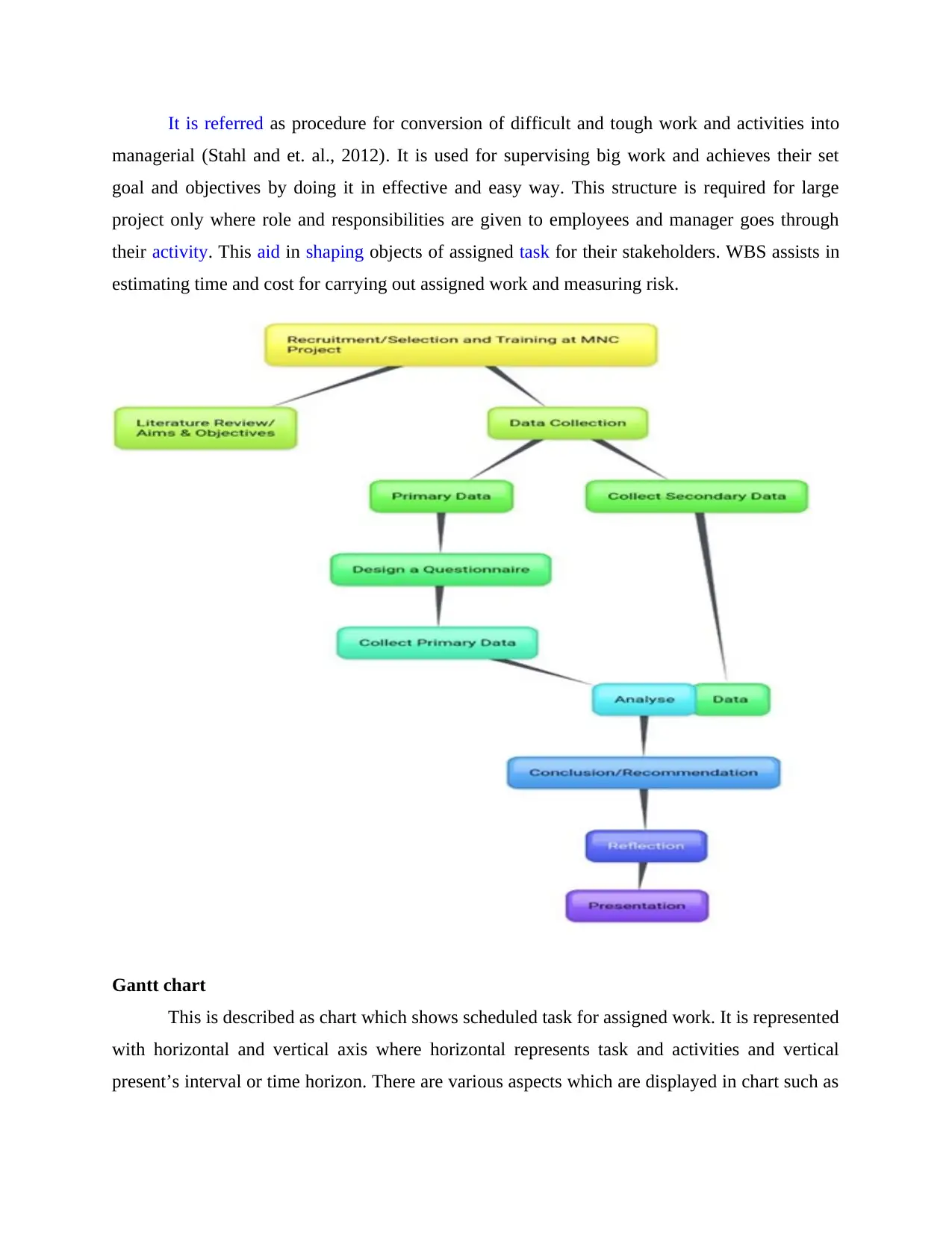
It is referred as procedure for conversion of difficult and tough work and activities into
managerial (Stahl and et. al., 2012). It is used for supervising big work and achieves their set
goal and objectives by doing it in effective and easy way. This structure is required for large
project only where role and responsibilities are given to employees and manager goes through
their activity. This aid in shaping objects of assigned task for their stakeholders. WBS assists in
estimating time and cost for carrying out assigned work and measuring risk.
Gantt chart
This is described as chart which shows scheduled task for assigned work. It is represented
with horizontal and vertical axis where horizontal represents task and activities and vertical
present’s interval or time horizon. There are various aspects which are displayed in chart such as
managerial (Stahl and et. al., 2012). It is used for supervising big work and achieves their set
goal and objectives by doing it in effective and easy way. This structure is required for large
project only where role and responsibilities are given to employees and manager goes through
their activity. This aid in shaping objects of assigned task for their stakeholders. WBS assists in
estimating time and cost for carrying out assigned work and measuring risk.
Gantt chart
This is described as chart which shows scheduled task for assigned work. It is represented
with horizontal and vertical axis where horizontal represents task and activities and vertical
present’s interval or time horizon. There are various aspects which are displayed in chart such as
⊘ This is a preview!⊘
Do you want full access?
Subscribe today to unlock all pages.

Trusted by 1+ million students worldwide

start, finish date, person carrying work, project time, interrelation among task, time duration for
carrying work and others. This is used in different kind of commercial enterprise and show
significant part in managing and achieves assigned project’s aims and objectives.
TASK 2
P4 Research Methodologies
It is characterized as methodologies which are used for aggregation of data and
information for given project. The different methodologies which are used by Nestle are as
follows:
Primary Research
This is defined as research that is conducted by an individual or person independently.
With help of this research, individual can directly collect data and information from their
consumers or respondents (Terpstra Foley and Sarathy, 2012). There are different methods such
as interviews, surveys, questionnaires from where data and information are collected. It is
expensive as well as time consuming but providing productive outcomes. The main benefits of
such research are that researcher gets instant outcome or feedback from consumers.
Secondary Research
carrying work and others. This is used in different kind of commercial enterprise and show
significant part in managing and achieves assigned project’s aims and objectives.
TASK 2
P4 Research Methodologies
It is characterized as methodologies which are used for aggregation of data and
information for given project. The different methodologies which are used by Nestle are as
follows:
Primary Research
This is defined as research that is conducted by an individual or person independently.
With help of this research, individual can directly collect data and information from their
consumers or respondents (Terpstra Foley and Sarathy, 2012). There are different methods such
as interviews, surveys, questionnaires from where data and information are collected. It is
expensive as well as time consuming but providing productive outcomes. The main benefits of
such research are that researcher gets instant outcome or feedback from consumers.
Secondary Research
Paraphrase This Document
Need a fresh take? Get an instant paraphrase of this document with our AI Paraphraser
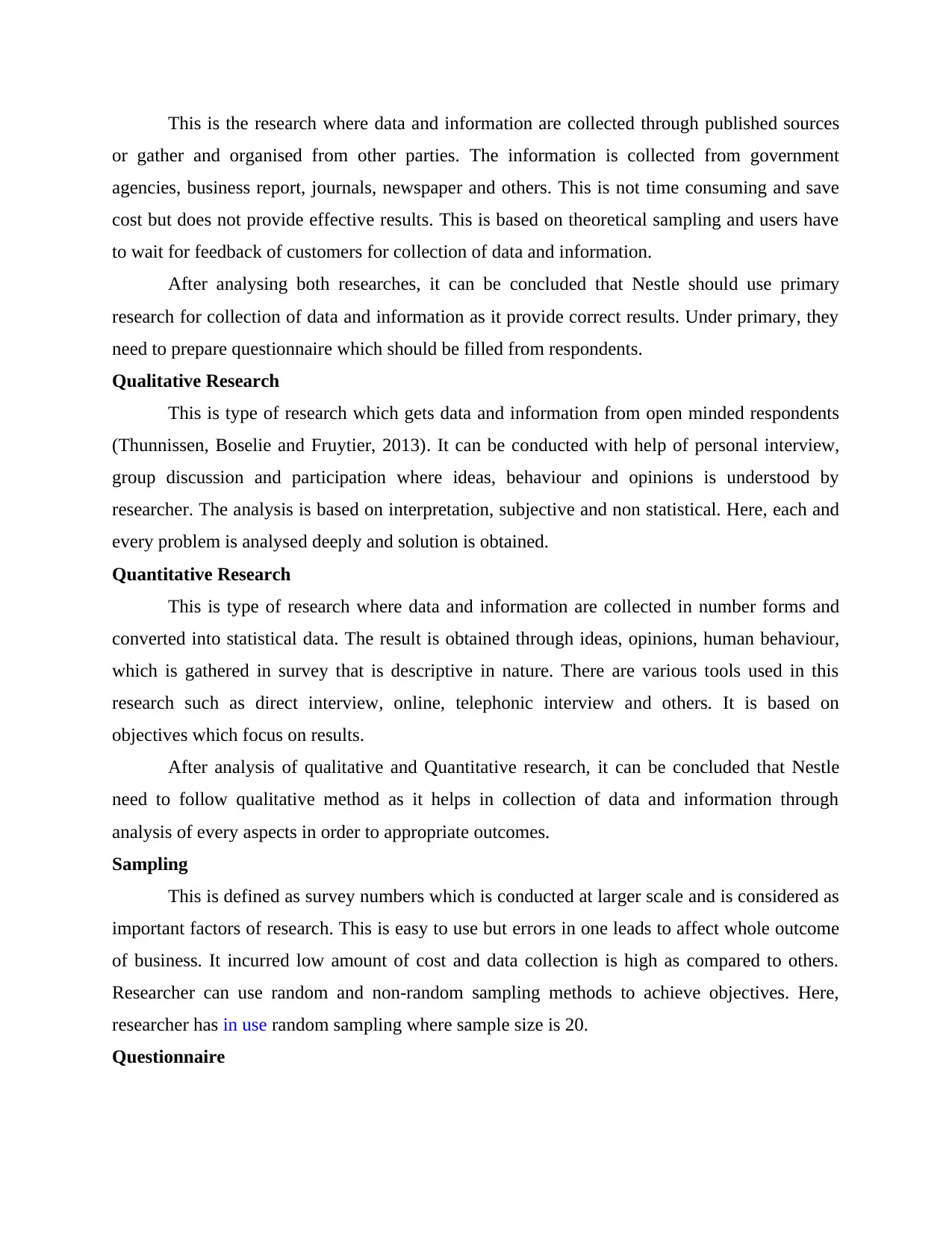
This is the research where data and information are collected through published sources
or gather and organised from other parties. The information is collected from government
agencies, business report, journals, newspaper and others. This is not time consuming and save
cost but does not provide effective results. This is based on theoretical sampling and users have
to wait for feedback of customers for collection of data and information.
After analysing both researches, it can be concluded that Nestle should use primary
research for collection of data and information as it provide correct results. Under primary, they
need to prepare questionnaire which should be filled from respondents.
Qualitative Research
This is type of research which gets data and information from open minded respondents
(Thunnissen, Boselie and Fruytier, 2013). It can be conducted with help of personal interview,
group discussion and participation where ideas, behaviour and opinions is understood by
researcher. The analysis is based on interpretation, subjective and non statistical. Here, each and
every problem is analysed deeply and solution is obtained.
Quantitative Research
This is type of research where data and information are collected in number forms and
converted into statistical data. The result is obtained through ideas, opinions, human behaviour,
which is gathered in survey that is descriptive in nature. There are various tools used in this
research such as direct interview, online, telephonic interview and others. It is based on
objectives which focus on results.
After analysis of qualitative and Quantitative research, it can be concluded that Nestle
need to follow qualitative method as it helps in collection of data and information through
analysis of every aspects in order to appropriate outcomes.
Sampling
This is defined as survey numbers which is conducted at larger scale and is considered as
important factors of research. This is easy to use but errors in one leads to affect whole outcome
of business. It incurred low amount of cost and data collection is high as compared to others.
Researcher can use random and non-random sampling methods to achieve objectives. Here,
researcher has in use random sampling where sample size is 20.
Questionnaire
or gather and organised from other parties. The information is collected from government
agencies, business report, journals, newspaper and others. This is not time consuming and save
cost but does not provide effective results. This is based on theoretical sampling and users have
to wait for feedback of customers for collection of data and information.
After analysing both researches, it can be concluded that Nestle should use primary
research for collection of data and information as it provide correct results. Under primary, they
need to prepare questionnaire which should be filled from respondents.
Qualitative Research
This is type of research which gets data and information from open minded respondents
(Thunnissen, Boselie and Fruytier, 2013). It can be conducted with help of personal interview,
group discussion and participation where ideas, behaviour and opinions is understood by
researcher. The analysis is based on interpretation, subjective and non statistical. Here, each and
every problem is analysed deeply and solution is obtained.
Quantitative Research
This is type of research where data and information are collected in number forms and
converted into statistical data. The result is obtained through ideas, opinions, human behaviour,
which is gathered in survey that is descriptive in nature. There are various tools used in this
research such as direct interview, online, telephonic interview and others. It is based on
objectives which focus on results.
After analysis of qualitative and Quantitative research, it can be concluded that Nestle
need to follow qualitative method as it helps in collection of data and information through
analysis of every aspects in order to appropriate outcomes.
Sampling
This is defined as survey numbers which is conducted at larger scale and is considered as
important factors of research. This is easy to use but errors in one leads to affect whole outcome
of business. It incurred low amount of cost and data collection is high as compared to others.
Researcher can use random and non-random sampling methods to achieve objectives. Here,
researcher has in use random sampling where sample size is 20.
Questionnaire
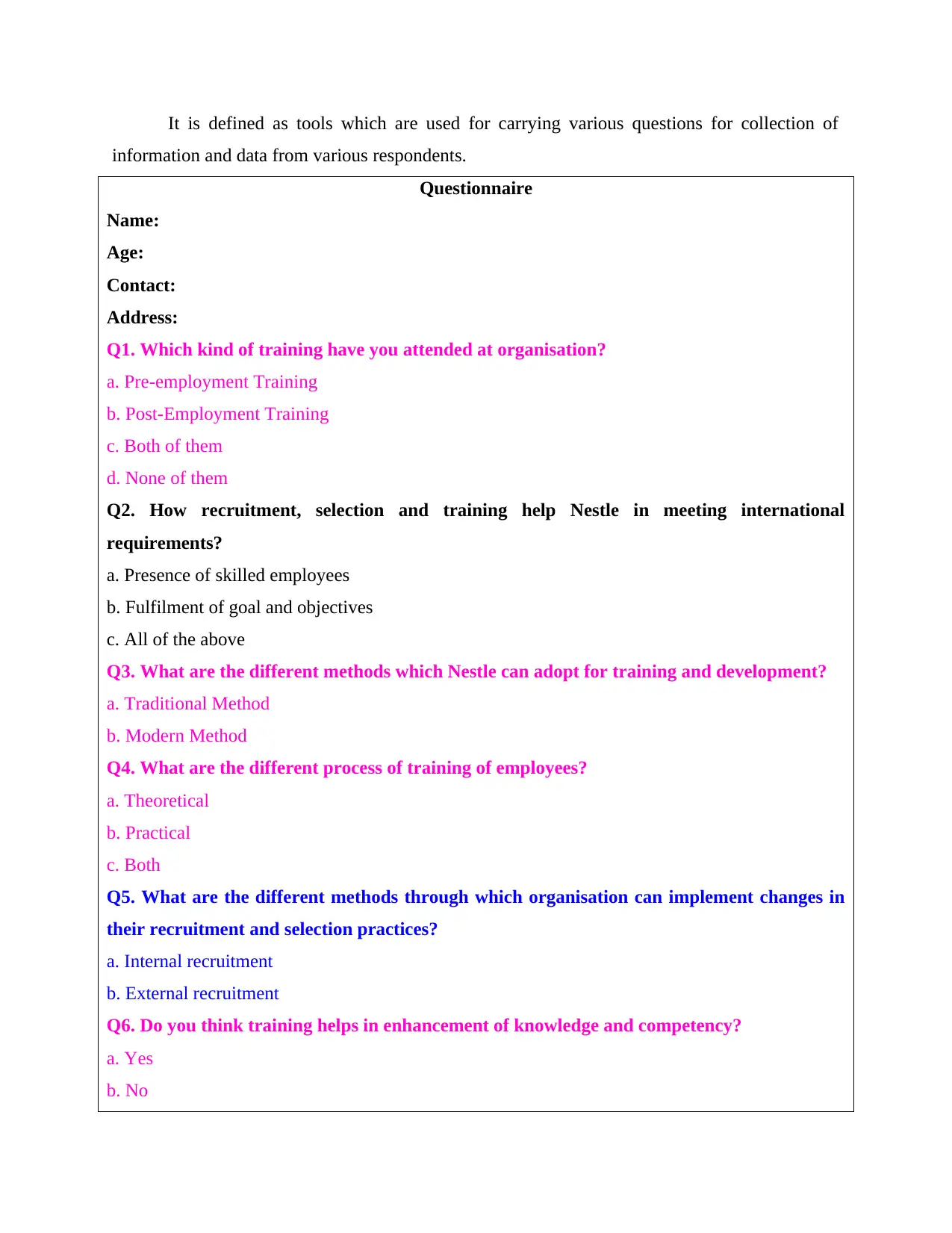
It is defined as tools which are used for carrying various questions for collection of
information and data from various respondents.
Questionnaire
Name:
Age:
Contact:
Address:
Q1. Which kind of training have you attended at organisation?
a. Pre-employment Training
b. Post-Employment Training
c. Both of them
d. None of them
Q2. How recruitment, selection and training help Nestle in meeting international
requirements?
a. Presence of skilled employees
b. Fulfilment of goal and objectives
c. All of the above
Q3. What are the different methods which Nestle can adopt for training and development?
a. Traditional Method
b. Modern Method
Q4. What are the different process of training of employees?
a. Theoretical
b. Practical
c. Both
Q5. What are the different methods through which organisation can implement changes in
their recruitment and selection practices?
a. Internal recruitment
b. External recruitment
Q6. Do you think training helps in enhancement of knowledge and competency?
a. Yes
b. No
information and data from various respondents.
Questionnaire
Name:
Age:
Contact:
Address:
Q1. Which kind of training have you attended at organisation?
a. Pre-employment Training
b. Post-Employment Training
c. Both of them
d. None of them
Q2. How recruitment, selection and training help Nestle in meeting international
requirements?
a. Presence of skilled employees
b. Fulfilment of goal and objectives
c. All of the above
Q3. What are the different methods which Nestle can adopt for training and development?
a. Traditional Method
b. Modern Method
Q4. What are the different process of training of employees?
a. Theoretical
b. Practical
c. Both
Q5. What are the different methods through which organisation can implement changes in
their recruitment and selection practices?
a. Internal recruitment
b. External recruitment
Q6. Do you think training helps in enhancement of knowledge and competency?
a. Yes
b. No
⊘ This is a preview!⊘
Do you want full access?
Subscribe today to unlock all pages.

Trusted by 1+ million students worldwide
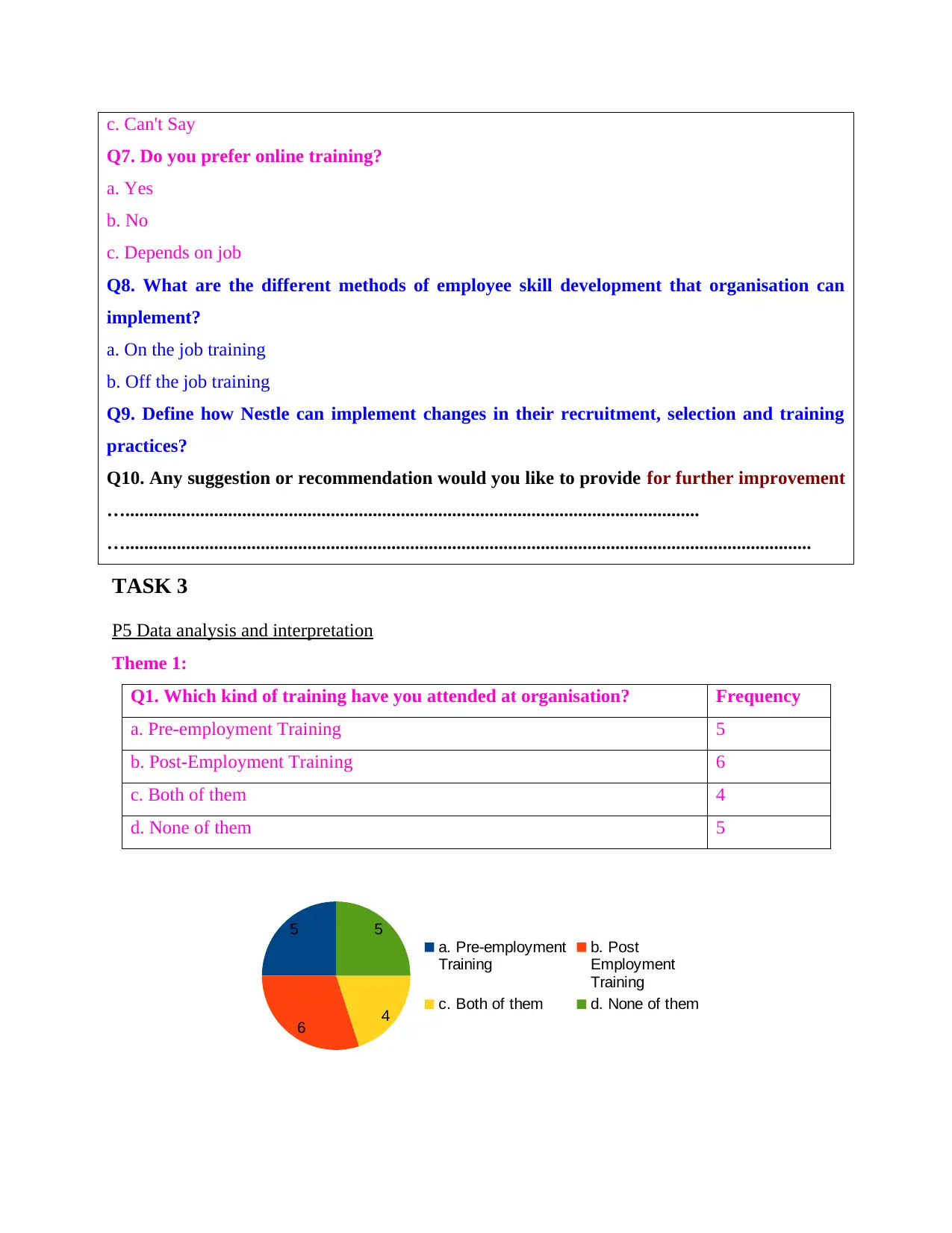
c. Can't Say
Q7. Do you prefer online training?
a. Yes
b. No
c. Depends on job
Q8. What are the different methods of employee skill development that organisation can
implement?
a. On the job training
b. Off the job training
Q9. Define how Nestle can implement changes in their recruitment, selection and training
practices?
Q10. Any suggestion or recommendation would you like to provide for further improvement
…...........................................................................................................................
…...................................................................................................................................................
TASK 3
P5 Data analysis and interpretation
Theme 1:
Q1. Which kind of training have you attended at organisation? Frequency
a. Pre-employment Training 5
b. Post-Employment Training 6
c. Both of them 4
d. None of them 5
5
6 4
5
a. Pre-employment
Training
b. Post
Employment
Training
c. Both of them d. None of them
Q7. Do you prefer online training?
a. Yes
b. No
c. Depends on job
Q8. What are the different methods of employee skill development that organisation can
implement?
a. On the job training
b. Off the job training
Q9. Define how Nestle can implement changes in their recruitment, selection and training
practices?
Q10. Any suggestion or recommendation would you like to provide for further improvement
…...........................................................................................................................
…...................................................................................................................................................
TASK 3
P5 Data analysis and interpretation
Theme 1:
Q1. Which kind of training have you attended at organisation? Frequency
a. Pre-employment Training 5
b. Post-Employment Training 6
c. Both of them 4
d. None of them 5
5
6 4
5
a. Pre-employment
Training
b. Post
Employment
Training
c. Both of them d. None of them
Paraphrase This Document
Need a fresh take? Get an instant paraphrase of this document with our AI Paraphraser
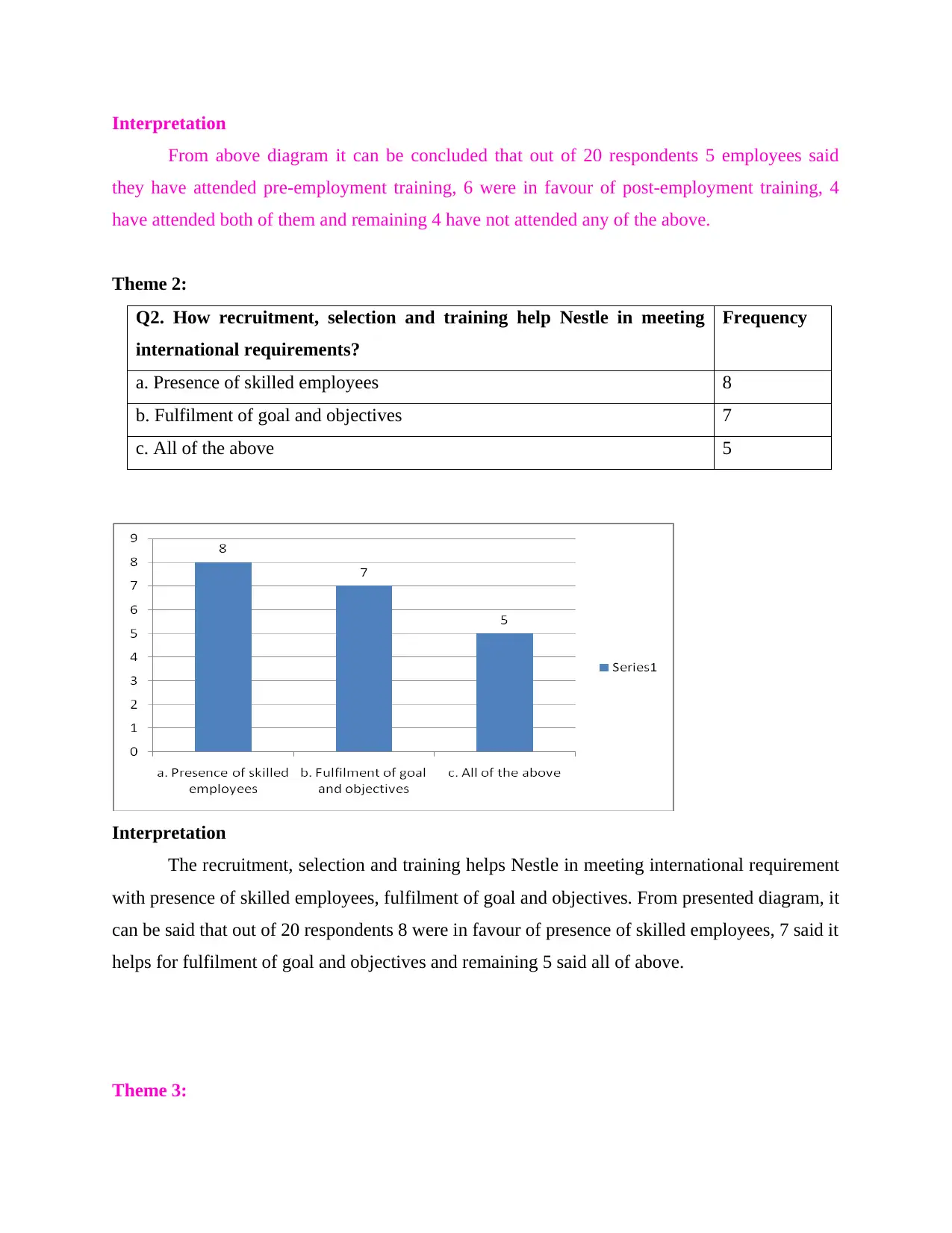
Interpretation
From above diagram it can be concluded that out of 20 respondents 5 employees said
they have attended pre-employment training, 6 were in favour of post-employment training, 4
have attended both of them and remaining 4 have not attended any of the above.
Theme 2:
Q2. How recruitment, selection and training help Nestle in meeting
international requirements?
Frequency
a. Presence of skilled employees 8
b. Fulfilment of goal and objectives 7
c. All of the above 5
Interpretation
The recruitment, selection and training helps Nestle in meeting international requirement
with presence of skilled employees, fulfilment of goal and objectives. From presented diagram, it
can be said that out of 20 respondents 8 were in favour of presence of skilled employees, 7 said it
helps for fulfilment of goal and objectives and remaining 5 said all of above.
Theme 3:
From above diagram it can be concluded that out of 20 respondents 5 employees said
they have attended pre-employment training, 6 were in favour of post-employment training, 4
have attended both of them and remaining 4 have not attended any of the above.
Theme 2:
Q2. How recruitment, selection and training help Nestle in meeting
international requirements?
Frequency
a. Presence of skilled employees 8
b. Fulfilment of goal and objectives 7
c. All of the above 5
Interpretation
The recruitment, selection and training helps Nestle in meeting international requirement
with presence of skilled employees, fulfilment of goal and objectives. From presented diagram, it
can be said that out of 20 respondents 8 were in favour of presence of skilled employees, 7 said it
helps for fulfilment of goal and objectives and remaining 5 said all of above.
Theme 3:
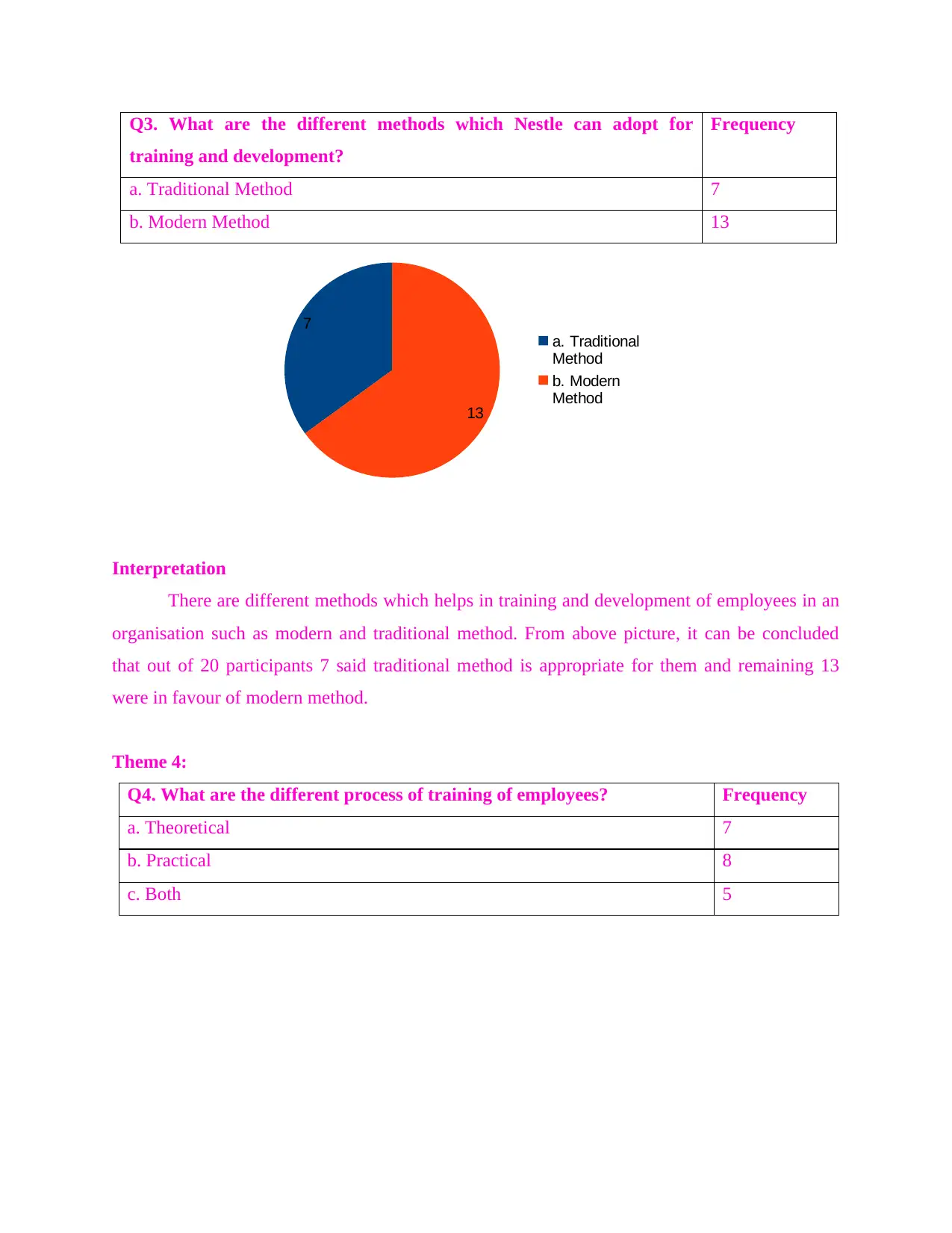
Q3. What are the different methods which Nestle can adopt for
training and development?
Frequency
a. Traditional Method 7
b. Modern Method 13
Interpretation
There are different methods which helps in training and development of employees in an
organisation such as modern and traditional method. From above picture, it can be concluded
that out of 20 participants 7 said traditional method is appropriate for them and remaining 13
were in favour of modern method.
Theme 4:
Q4. What are the different process of training of employees? Frequency
a. Theoretical 7
b. Practical 8
c. Both 5
7
13
a. Traditional
Method
b. Modern
Method
training and development?
Frequency
a. Traditional Method 7
b. Modern Method 13
Interpretation
There are different methods which helps in training and development of employees in an
organisation such as modern and traditional method. From above picture, it can be concluded
that out of 20 participants 7 said traditional method is appropriate for them and remaining 13
were in favour of modern method.
Theme 4:
Q4. What are the different process of training of employees? Frequency
a. Theoretical 7
b. Practical 8
c. Both 5
7
13
a. Traditional
Method
b. Modern
Method
⊘ This is a preview!⊘
Do you want full access?
Subscribe today to unlock all pages.

Trusted by 1+ million students worldwide
1 out of 23
Related Documents
Your All-in-One AI-Powered Toolkit for Academic Success.
+13062052269
info@desklib.com
Available 24*7 on WhatsApp / Email
![[object Object]](/_next/static/media/star-bottom.7253800d.svg)
Unlock your academic potential
Copyright © 2020–2025 A2Z Services. All Rights Reserved. Developed and managed by ZUCOL.





